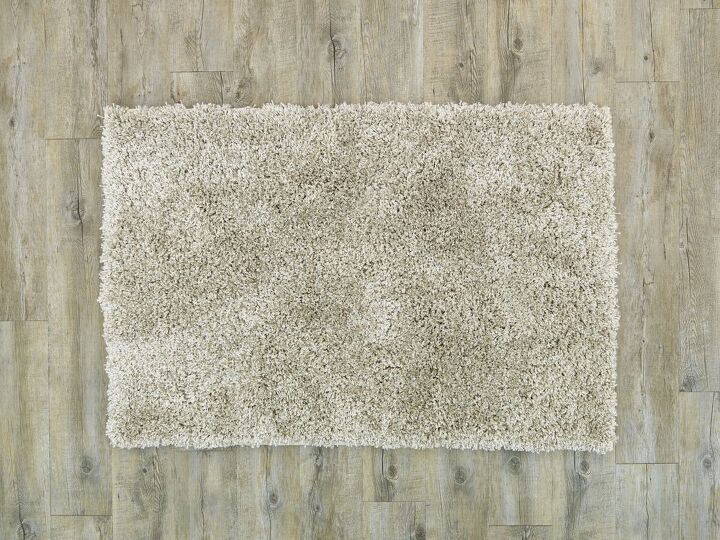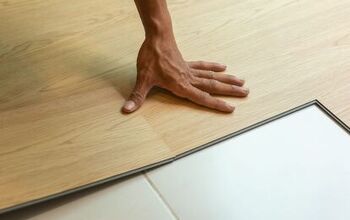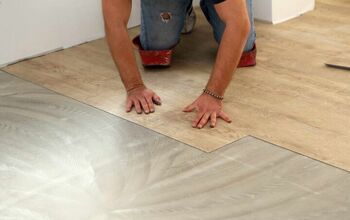Can You Put Rugs on Vinyl Plank Flooring?

Is your vinyl plank flooring starting to look rough in some spots or are you just trying to dress up the room? You may be tempted to toss a rug down and be done with it.
What is most important when considering whether you can put rugs on vinyl plank flooring is checking to see if the rug is safe to use on vinyl flooring. Rubber is not a safe option for vinyl as it can permanently damage your flooring. Rugs which can be used include wool, coir, sisal, jute, and cotton.
Vinyl flooring is a great alternative to tile and hardwood because it is more affordable than real wood and comes in so many stunning choices and styles. Read on to find out more about rugs and vinyl plank flooring.
Are you looking for carpet installers?
Get free, zero-commitment quotes from pro contractors near you.

What is Vinyl Plank Flooring?
Made to resemble real hardwood floors, vinyl plank flooring is made just like vinyl flooring but shaped in planks, or rectangles. The strips make it look like real wood planks, from hickory to oak. It comes in many different shades and is water-resistant, unlike real wood or laminate.
Made of polyvinyl chloride mixed with a plasticizer, the synthetic material of the flooring is versatile, inexpensive, and has many different styles and colors. You can use it anywhere and it can withstand heavy use from kids and pets. Since it is waterproof, you can also use it in the kitchen and bathroom as well.
Types of Rugs You Can Use with Vinyl Plank Flooring
Natural weave rugs are perfectly fine to use on vinyl plank floors and they come in many colors, designs, and sizes. Some of the best choices for your vinyl plank floors include:
- Wool is a beautiful and long-lasting alternative that has been used in rugs for centuries. However, it can be expensive.
- Coir is made from the husk of coconuts, which is also a bit rough on the skin. However, it is water-resistant and can handle heavy foot traffic.
- Sisal is created from the fibers of the agave plant. It is a durable and tough fiber but is not very comfortable on bare feet.
- Jute comes from Bangladesh and India and is available in many weaves. It can be dyed easily and is beautiful but does not last as long as other natural fibers.
- Bamboo is an excellent choice for softness, durability, and style. However, they tend to cost more than the others.
- Cotton is less expensive than wool and softer to the feel than sisal, jute, or coir. Most are machine washable and last a very long time.
- Seagrass, which is typically from marshes in India or China, is a resilient fiber that is softer than the others. It comes in many different colors and weaves.
Types of Rugs You Cannot Use
Although rubber backed floor coverings are great for not slipping and sliding on your smooth floor, they are not a good match for your vinyl plank flooring. The plasticizers like latex or petroleum that are added to the rubber can cause discoloration or fading of your floor.
Another reason that rubber-backed rugs are not good is that they block the circulation. With no air circulation, the rubber can stick to the floor and will have to be scraped off. That will cause even more damage. If you have a really nice rubber backed rug that you cannot part with, get a rug pad.
Rug pads come in many styles and sizes, but you have to make sure to get one made of natural fiber. Just like with the rug itself, the rug pad cannot have any rubber or latex that will react with the vinyl on the flooring. Try to find one that says it is made for vinyl plank flooring to be on the safe side.
Vinyl Plank Flooring Advantages
Vinyl plank flooring is extremely durable and great for families with kids and pets. It is also waterproof and can be cleaned with a wet mop or steam mop. You do not have to wax or polish your vinyl plank floor as you do with hardwood.
Vinyl flooring and vinyl plank flooring are actually the same thing. The only difference is the shape since vinyl flooring typically comes in sheets or squares while vinyl plank flooring is a rectangular plank. It looks more like real wood and some say it is easier to install.
Vinyl Plank Flooring Disadvantages
Because the vinyl is softer than the other choices, heavy items and sharp objects can cause abrasions, scratches, and even permanent damage. Compared to laminate flooring, vinyl plank flooring is more expensive. But it is cheaper than real wood.
In addition, just a tiny bit of dust or dirt left under the flooring can turn into a lump in the floor later because the vinyl shapes itself around the spot. So, make sure you don’t let any dirt or dust get under there when installing.
Taking Care of Your Vinyl Plank Flooring
With all of the new innovative technology, vinyl flooring has changed from those hideous shiny squares like your grandma had to planks that actually look like wood. It is nice to have the look of wood without having to worry about the care of wood. Because real wood floors are much more difficult to maintain.
Direct sunlight can fade or discolor your flooring, so this is a perfect opportunity for those vinyl-approved rugs. It is also good to keep a small rug in front of each outside door to prevent dirt and small particles from being tracked inside.
Put felt or cotton pads under your furniture and other heavy items to prevent dents in the floor. You may also want to move your furniture around a few times a year to keep the floor from getting pitted. Area rugs under your furniture can help too, as long as they are not backed with rubber or latex.
Are you looking for carpet installers?
Get free, zero-commitment quotes from pro contractors near you.

Keeping It Clean
For your vinyl plank flooring, you can keep your floors clean using the same techniques you would expect to use. Sweeping or vacuuming and mopping. When you vacuum, do not use the beater bar because it can cause scratches on the vinyl.
Since it is waterproof, you can use a mop or a steam mop to clean it when needed. Do not use wax or any kind of solvent polish or it can damage the flooring. Harsh cleaners and detergents are also not recommended. Some of the most common cleaners used on vinyl plank flooring include:
- Distilled white vinegar and water
- Baking soda and water
- Dish soap and degreaser with water
- Rubbing alcohol for stains like ink, grease, and cosmetics
- WD-40 to remove scuff marks
Tip: Harsh cleaners such as scouring power or ammonia will damage your vinyl plank flooring. Also, products that say you can just mop, and it will shine like new tend to leave a film on the floor that makes it even dirtier. You should always read the label to be sure it is safe to use on vinyl flooring and whether or not you need to rinse it.
The main thing to remember is that sand and small particles can cause damage to the flooring so you should keep it clean with a vacuum as needed. When mopping, use a cleaner that is approved for vinyl flooring. Although it is waterproof, it is not good to saturate it because leaving a lot of water on it can cause damage.
Whichever rug you choose, make sure it is securely anchored to the floor with a rug mat or by placing furniture on top of it. Rugs can be extremely slippery on vinyl flooring and you do not want to have any falls.

I am a DIYer who loves writing about anything home-related. When I am not writing, you can find me studying for my PhD in Psychology, photographing nature, and swimming at the lake with my grandkids.
More by Patricia Oelze























![How To Reset A Whirlpool Cabrio Washer [In 5 Easy Steps!]](https://cdn-fastly.upgradedhome.com/media/2023/07/31/9076531/how-to-reset-a-whirlpool-cabrio-washer-in-5-easy-steps.jpg?size=350x220)



